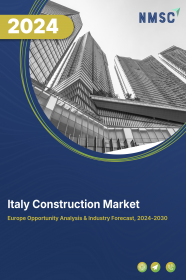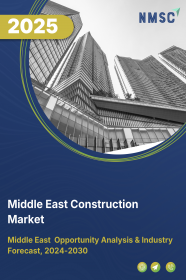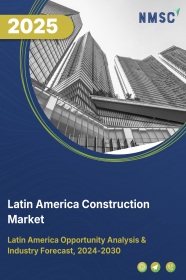
Italy Construction Market by Type (Renovation, and New Construction), by Construction Method (Traditional, Prefabricated/Modular, 3D-Printed, and Green/Sustainable), by Contractor Type (Large Contractor, Medium Contractor, and Small Contractor), and Sector (Real Estate, Commercial, Infrastructure, Industrial) – Industry Trends and Forecast, 2025–2030
Industry: Construction & Manufacturing | Publish Date: 06-Jun-2025 | No of Pages: 75 | No. of Tables: 87 | No. of Figures: 52 | Format: PDF | Report Code : CM2200
US Tariff Impact on Italy Construction Market
Trump Tariffs Are Reshaping Global Business
Italy Construction Industry Overview
The Italy Construction Market size was valued at USD 289.04 billion in 2024, and is projected to grow to USD 311.72 billion by 2025. Additionally, the industry is expected to continue its growth trajectory, reaching USD 354.32 billion by 2030, with a CAGR of 2.6% from 2025 to 2030.
Italy construction market is experiencing significant growth driven by increased infrastructure investments, primarily due to government initiatives such as the National Recovery and Resilience Plan (NRRP), which aims to modernize the country’s infrastructure.
Major projects like the Messina Bridge and railway investments highlight the government's commitment to boosting construction activity. However, the sector faces challenges from complex regulatory frameworks and lengthy permitting processes, which can delay projects and increase costs.
Despite these hurdles, the integration of digitalization and Building Information Modeling (BIM) is transforming the industry, offering new opportunities for efficiency, collaboration, and innovation in infrastructure development.
Surge in Infrastructure Investments is Fueling Italy Construction Market Trends
Italy construction market is experiencing a surge in growth, largely driven by a significant rise in infrastructure investments. The National Association of Building Contractors (ANCE) reports a 20% increase in infrastructure investments in 2024, reaching USD 208.5 billion compared to the previous year.
This increase is primarily attributed to accelerated spending under the National Recovery and Resilience Plan (NRRP), which aims to modernize and strengthen the country's infrastructure. As a result, infrastructure development is significantly boosting market growth.
Rise in Government Initiatives is Boosting Italy Construction Market Demand
The Italian government has taken substantial steps to support the Italy construction market growth. In 2024, the government advanced the Messina Bridge project, a USD 10.85 billion initiative to construct the world’s longest suspension bridge (3.3 km span) connecting Sicily to mainland Italy, with construction starting in 2024 and completion targeted for 2032.
Additionally, USD 6.51 billion was allocated in 2024 to continue reconstruction efforts in central Italy, focusing on rebuilding infrastructure and housing damaged by earthquakes since 2009, including the 2016 Amatrice quake.
Other key initiatives include the USD 106.4 billion railway investment plan by Rete Ferroviaria Italiana (2025–2029) for high-speed rail and regional connectivity, and USD 25 billion by Terna (2025–2034) to enhance renewable energy infrastructure, aligning with Italy’s 70% renewable electricity goal by 2030. These efforts underscore the government’s commitment to modernizing infrastructure and bolstering the construction sector.
Regulatory Complexities Impede the Italy Construction Market Expansion
The construction market grapples with significant challenges arising from stringent regulatory frameworks. Infrastructure ventures face obstacles due to the intricate network of government regulations and permitting processes.
Infrastructure projects typically entail securing numerous permits and approvals from governmental bodies at local, regional, and national levels. These permissions encompass zoning regulations, environmental assessments, compliance with building codes, safety standards, and various regulatory requirements.
Lengthy permit acquisition processes, bureaucratic inefficiencies, and regulatory disparities among jurisdictions can significantly prolong project timelines and inflate costs. Additionally, fluctuations in regulations or unexpected policy changes can disrupt ongoing projects and discourage potential investments.
For instance, the Environmental Protection Agency (EPA) oversees various aspects of the infrastructure sector, including air quality, lead management, waste disposal, and water regulations.
The EPA's compliance assistance centers offer resources to facilitate environmental compliance during demolition activities, the recycling of infrastructure materials, and the proper disposal of refrigeration and air-conditioning equipment.
Integration of Digitalization and BIM Presents Lucrative Opportunity for the Market Expansion
The construction industry is undergoing a significant digital transformation, driven by the increasing adoption of Building Information Modeling (BIM), which is opening up new avenues for growth. BIM supports digital design, simulation, and infrastructure oversight, improving precision, collaboration, and resource optimization.
Reflecting this trend, ALLPLAN launched Allplan 2024-1 in April 2024 to enhance BIM capabilities and streamline cloud-based workflows, underscoring the sector’s shift toward fully digital project execution. Moreover, the convergence of AI, IoT, and cloud technologies is further enabling real-time collaboration, predictive maintenance, and efficient facility management.
Competitive Landscape
The key players operating in the Italy construction industry include Saipem S.p.A., Webuild S.p.A., MAIRE S.p.A., Bonatti, ASTM S.p.A., SICIM S.p.A., Impresa Pizzarotti & C., Vinci SA, Strabag SE, Eiffage S.A., and others.
Italy Construction Market Key Segments
By Type
-
Renovation
-
New Construction
By Construction Method
-
Traditional Construction
-
Prefabricated/Modular Construction
-
3D-Printed Construction
-
Green/Sustainable Construction
By Type of Contractor
-
Large Contractor
-
Medium Contractor
-
Small Contractor
By Sector
-
Real Estate
-
Residential
-
Affordable
-
Luxury
-
-
Commercial
-
Retail Buildings
-
Office Buildings
-
Hospitality
-
Healthcare Facilities
-
Educational Institutes
-
Entertainment Ventures
-
-
-
Infrastructure
-
Transportation
-
Airport
-
Port
-
Rail
-
Road
-
-
Water and Wastewater
-
Energy
-
Telecommunication
-
-
Industrial
-
Manufacturing Plant
-
Warehouses
-
Power Plants
-
Oil Refineries
-
Chemical Plants
-
Key Players
-
Saipem S.p.A.
-
Webuild S.p.A.
-
MAIRE S.p.A.
-
Bonatti
-
ASTM S.p.A.
-
SICIM S.p.A.
-
Impresa Pizzarotti & C.
-
Vinci SA
-
Strabag SE
-
Eiffage S.A.
REPORT SCOPE AND SEGMENTATION:
|
Parameters |
Details |
|
Market Size in 2024 |
USD 289.04 Billion |
|
Revenue Forecast in 2030 |
USD 354.32 Billion |
|
Growth Rate |
CAGR of 2.6% from 2025 to 2030 |
|
Analysis Period |
2024–2030 |
|
Base Year Considered |
2024 |
|
Forecast Period |
2025–2030 |
|
Market Size Estimation |
Billion (USD) |
|
Growth Factors |
|
|
Companies Profiled |
10 |
|
Market Share |
Available for 10 companies |
|
Customization Scope |
Free customization (equivalent up to 80 working hours of analysts) after purchase. Addition or alteration to country, regional, and segment scope. |
|
Pricing and Purchase Options |
Avail customized purchase options to meet your exact research needs. |

















 Speak to Our Analyst
Speak to Our Analyst

















